Analysis of Taxi and Uber Economics: Price and Elasticity
VerifiedAdded on 2020/03/01
|5
|1389
|23
Homework Assignment
AI Summary
This economics assignment analyzes the comparative economics of taxi and Uber services, focusing on price differences, elasticity of demand, and market dynamics. The solution begins with a price comparison between taxi and UberX rides from Deakin College to Melbourne CBD, highlighting factors like dynamic pricing used by UberX versus fixed fares in traditional taxis. The assignment further explores the impact of UberX on the supply and demand curves, illustrating how the introduction of ride-sharing increases supply, lowers prices, and increases the number of riders, resulting in a rise in total surplus. The analysis then delves into price elasticity of demand, comparing the inelastic demand for traditional taxi services with the more elastic demand created by the availability of UberX as a substitute. The factors influencing elasticity, such as substitutes, necessity versus luxury, and time period are also examined. The assignment also addresses the implications of fixing fares, demonstrating how price controls can lead to market inefficiencies and deadweight loss, contrasting this with the efficiency of dynamic pricing models used by Uber. Finally, the solution includes a comprehensive list of references.
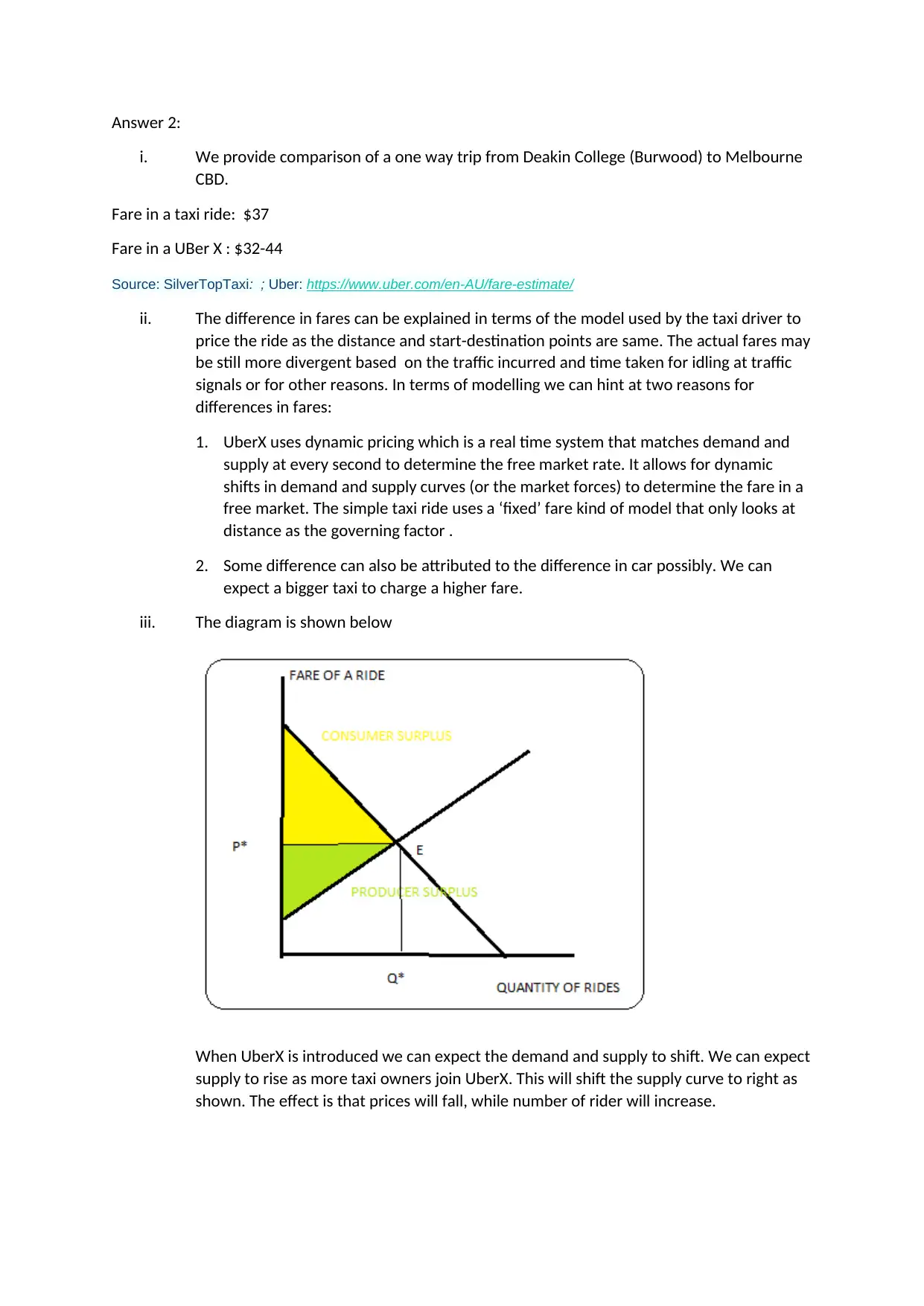
Answer 2:
i. We provide comparison of a one way trip from Deakin College (Burwood) to Melbourne
CBD.
Fare in a taxi ride: $37
Fare in a UBer X : $32-44
Source: SilverTopTaxi: ; Uber: https://www.uber.com/en-AU/fare-estimate/
ii. The difference in fares can be explained in terms of the model used by the taxi driver to
price the ride as the distance and start-destination points are same. The actual fares may
be still more divergent based on the traffic incurred and time taken for idling at traffic
signals or for other reasons. In terms of modelling we can hint at two reasons for
differences in fares:
1. UberX uses dynamic pricing which is a real time system that matches demand and
supply at every second to determine the free market rate. It allows for dynamic
shifts in demand and supply curves (or the market forces) to determine the fare in a
free market. The simple taxi ride uses a ‘fixed’ fare kind of model that only looks at
distance as the governing factor .
2. Some difference can also be attributed to the difference in car possibly. We can
expect a bigger taxi to charge a higher fare.
iii. The diagram is shown below
When UberX is introduced we can expect the demand and supply to shift. We can expect
supply to rise as more taxi owners join UberX. This will shift the supply curve to right as
shown. The effect is that prices will fall, while number of rider will increase.
i. We provide comparison of a one way trip from Deakin College (Burwood) to Melbourne
CBD.
Fare in a taxi ride: $37
Fare in a UBer X : $32-44
Source: SilverTopTaxi: ; Uber: https://www.uber.com/en-AU/fare-estimate/
ii. The difference in fares can be explained in terms of the model used by the taxi driver to
price the ride as the distance and start-destination points are same. The actual fares may
be still more divergent based on the traffic incurred and time taken for idling at traffic
signals or for other reasons. In terms of modelling we can hint at two reasons for
differences in fares:
1. UberX uses dynamic pricing which is a real time system that matches demand and
supply at every second to determine the free market rate. It allows for dynamic
shifts in demand and supply curves (or the market forces) to determine the fare in a
free market. The simple taxi ride uses a ‘fixed’ fare kind of model that only looks at
distance as the governing factor .
2. Some difference can also be attributed to the difference in car possibly. We can
expect a bigger taxi to charge a higher fare.
iii. The diagram is shown below
When UberX is introduced we can expect the demand and supply to shift. We can expect
supply to rise as more taxi owners join UberX. This will shift the supply curve to right as
shown. The effect is that prices will fall, while number of rider will increase.
Paraphrase This Document
Need a fresh take? Get an instant paraphrase of this document with our AI Paraphraser
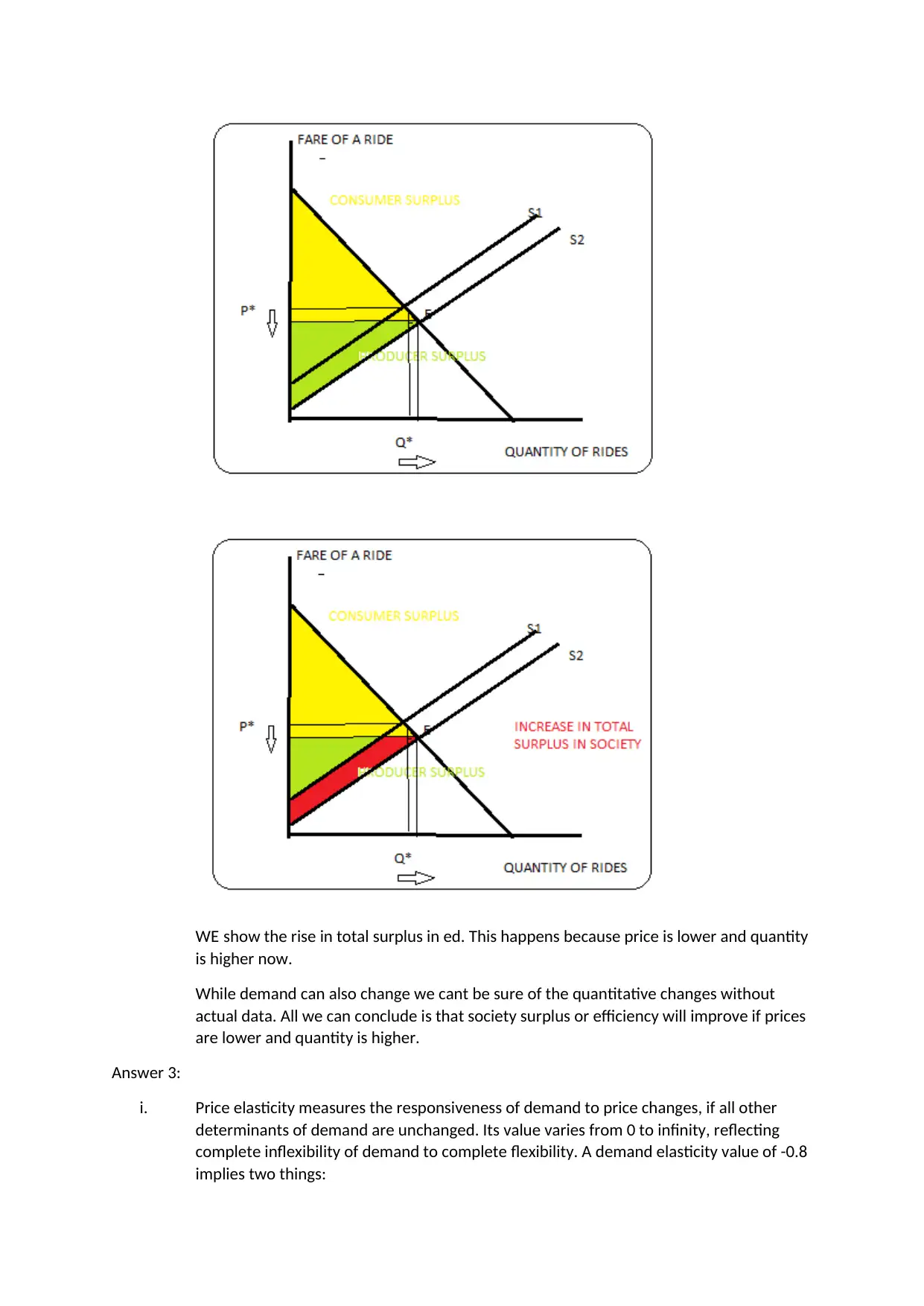
WE show the rise in total surplus in ed. This happens because price is lower and quantity
is higher now.
While demand can also change we cant be sure of the quantitative changes without
actual data. All we can conclude is that society surplus or efficiency will improve if prices
are lower and quantity is higher.
Answer 3:
i. Price elasticity measures the responsiveness of demand to price changes, if all other
determinants of demand are unchanged. Its value varies from 0 to infinity, reflecting
complete inflexibility of demand to complete flexibility. A demand elasticity value of -0.8
implies two things:
is higher now.
While demand can also change we cant be sure of the quantitative changes without
actual data. All we can conclude is that society surplus or efficiency will improve if prices
are lower and quantity is higher.
Answer 3:
i. Price elasticity measures the responsiveness of demand to price changes, if all other
determinants of demand are unchanged. Its value varies from 0 to infinity, reflecting
complete inflexibility of demand to complete flexibility. A demand elasticity value of -0.8
implies two things:
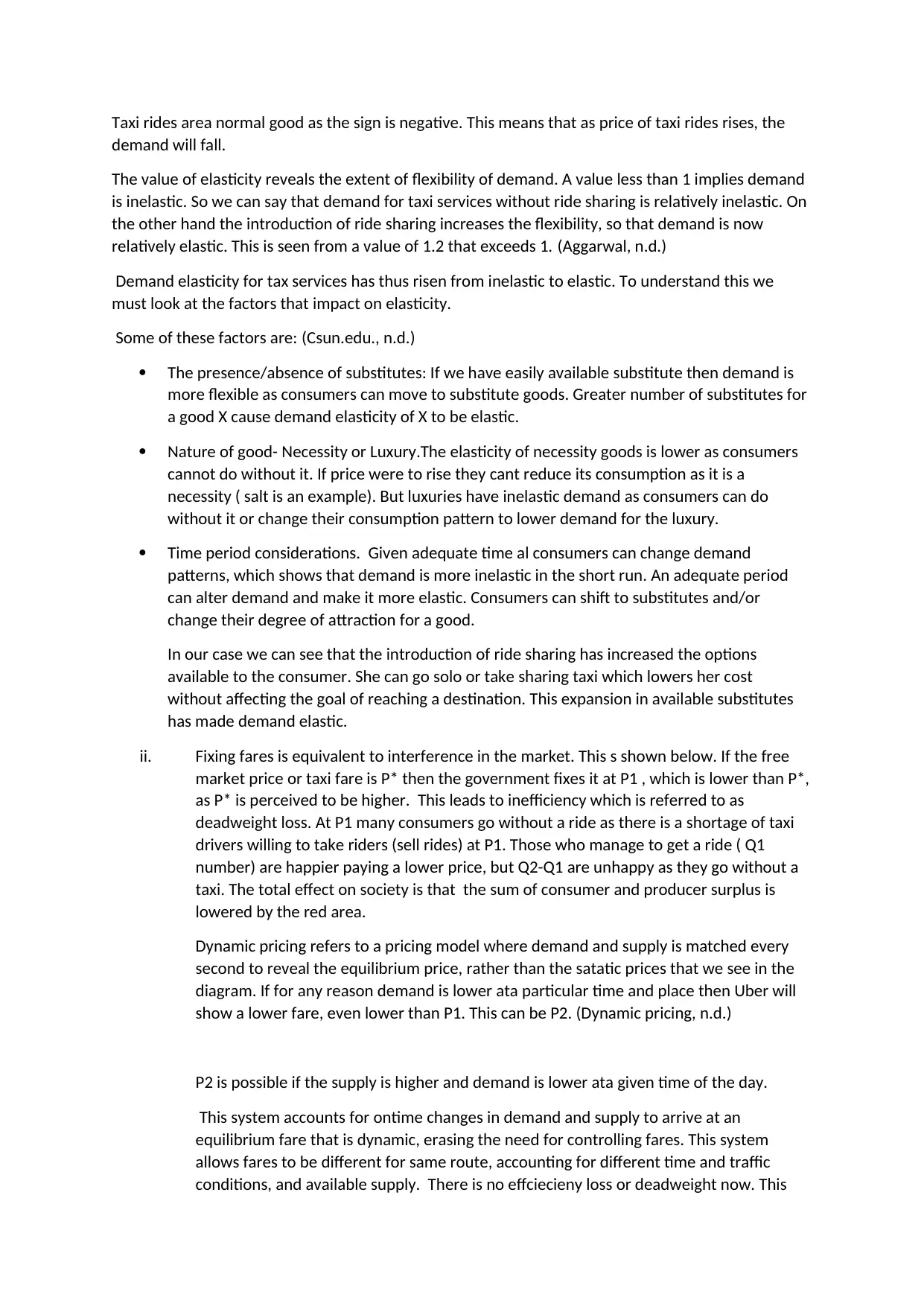
Taxi rides area normal good as the sign is negative. This means that as price of taxi rides rises, the
demand will fall.
The value of elasticity reveals the extent of flexibility of demand. A value less than 1 implies demand
is inelastic. So we can say that demand for taxi services without ride sharing is relatively inelastic. On
the other hand the introduction of ride sharing increases the flexibility, so that demand is now
relatively elastic. This is seen from a value of 1.2 that exceeds 1. (Aggarwal, n.d.)
Demand elasticity for tax services has thus risen from inelastic to elastic. To understand this we
must look at the factors that impact on elasticity.
Some of these factors are: (Csun.edu., n.d.)
The presence/absence of substitutes: If we have easily available substitute then demand is
more flexible as consumers can move to substitute goods. Greater number of substitutes for
a good X cause demand elasticity of X to be elastic.
Nature of good- Necessity or Luxury.The elasticity of necessity goods is lower as consumers
cannot do without it. If price were to rise they cant reduce its consumption as it is a
necessity ( salt is an example). But luxuries have inelastic demand as consumers can do
without it or change their consumption pattern to lower demand for the luxury.
Time period considerations. Given adequate time al consumers can change demand
patterns, which shows that demand is more inelastic in the short run. An adequate period
can alter demand and make it more elastic. Consumers can shift to substitutes and/or
change their degree of attraction for a good.
In our case we can see that the introduction of ride sharing has increased the options
available to the consumer. She can go solo or take sharing taxi which lowers her cost
without affecting the goal of reaching a destination. This expansion in available substitutes
has made demand elastic.
ii. Fixing fares is equivalent to interference in the market. This s shown below. If the free
market price or taxi fare is P* then the government fixes it at P1 , which is lower than P*,
as P* is perceived to be higher. This leads to inefficiency which is referred to as
deadweight loss. At P1 many consumers go without a ride as there is a shortage of taxi
drivers willing to take riders (sell rides) at P1. Those who manage to get a ride ( Q1
number) are happier paying a lower price, but Q2-Q1 are unhappy as they go without a
taxi. The total effect on society is that the sum of consumer and producer surplus is
lowered by the red area.
Dynamic pricing refers to a pricing model where demand and supply is matched every
second to reveal the equilibrium price, rather than the satatic prices that we see in the
diagram. If for any reason demand is lower ata particular time and place then Uber will
show a lower fare, even lower than P1. This can be P2. (Dynamic pricing, n.d.)
P2 is possible if the supply is higher and demand is lower ata given time of the day.
This system accounts for ontime changes in demand and supply to arrive at an
equilibrium fare that is dynamic, erasing the need for controlling fares. This system
allows fares to be different for same route, accounting for different time and traffic
conditions, and available supply. There is no effciecieny loss or deadweight now. This
demand will fall.
The value of elasticity reveals the extent of flexibility of demand. A value less than 1 implies demand
is inelastic. So we can say that demand for taxi services without ride sharing is relatively inelastic. On
the other hand the introduction of ride sharing increases the flexibility, so that demand is now
relatively elastic. This is seen from a value of 1.2 that exceeds 1. (Aggarwal, n.d.)
Demand elasticity for tax services has thus risen from inelastic to elastic. To understand this we
must look at the factors that impact on elasticity.
Some of these factors are: (Csun.edu., n.d.)
The presence/absence of substitutes: If we have easily available substitute then demand is
more flexible as consumers can move to substitute goods. Greater number of substitutes for
a good X cause demand elasticity of X to be elastic.
Nature of good- Necessity or Luxury.The elasticity of necessity goods is lower as consumers
cannot do without it. If price were to rise they cant reduce its consumption as it is a
necessity ( salt is an example). But luxuries have inelastic demand as consumers can do
without it or change their consumption pattern to lower demand for the luxury.
Time period considerations. Given adequate time al consumers can change demand
patterns, which shows that demand is more inelastic in the short run. An adequate period
can alter demand and make it more elastic. Consumers can shift to substitutes and/or
change their degree of attraction for a good.
In our case we can see that the introduction of ride sharing has increased the options
available to the consumer. She can go solo or take sharing taxi which lowers her cost
without affecting the goal of reaching a destination. This expansion in available substitutes
has made demand elastic.
ii. Fixing fares is equivalent to interference in the market. This s shown below. If the free
market price or taxi fare is P* then the government fixes it at P1 , which is lower than P*,
as P* is perceived to be higher. This leads to inefficiency which is referred to as
deadweight loss. At P1 many consumers go without a ride as there is a shortage of taxi
drivers willing to take riders (sell rides) at P1. Those who manage to get a ride ( Q1
number) are happier paying a lower price, but Q2-Q1 are unhappy as they go without a
taxi. The total effect on society is that the sum of consumer and producer surplus is
lowered by the red area.
Dynamic pricing refers to a pricing model where demand and supply is matched every
second to reveal the equilibrium price, rather than the satatic prices that we see in the
diagram. If for any reason demand is lower ata particular time and place then Uber will
show a lower fare, even lower than P1. This can be P2. (Dynamic pricing, n.d.)
P2 is possible if the supply is higher and demand is lower ata given time of the day.
This system accounts for ontime changes in demand and supply to arrive at an
equilibrium fare that is dynamic, erasing the need for controlling fares. This system
allows fares to be different for same route, accounting for different time and traffic
conditions, and available supply. There is no effciecieny loss or deadweight now. This
⊘ This is a preview!⊘
Do you want full access?
Subscribe today to unlock all pages.

Trusted by 1+ million students worldwide
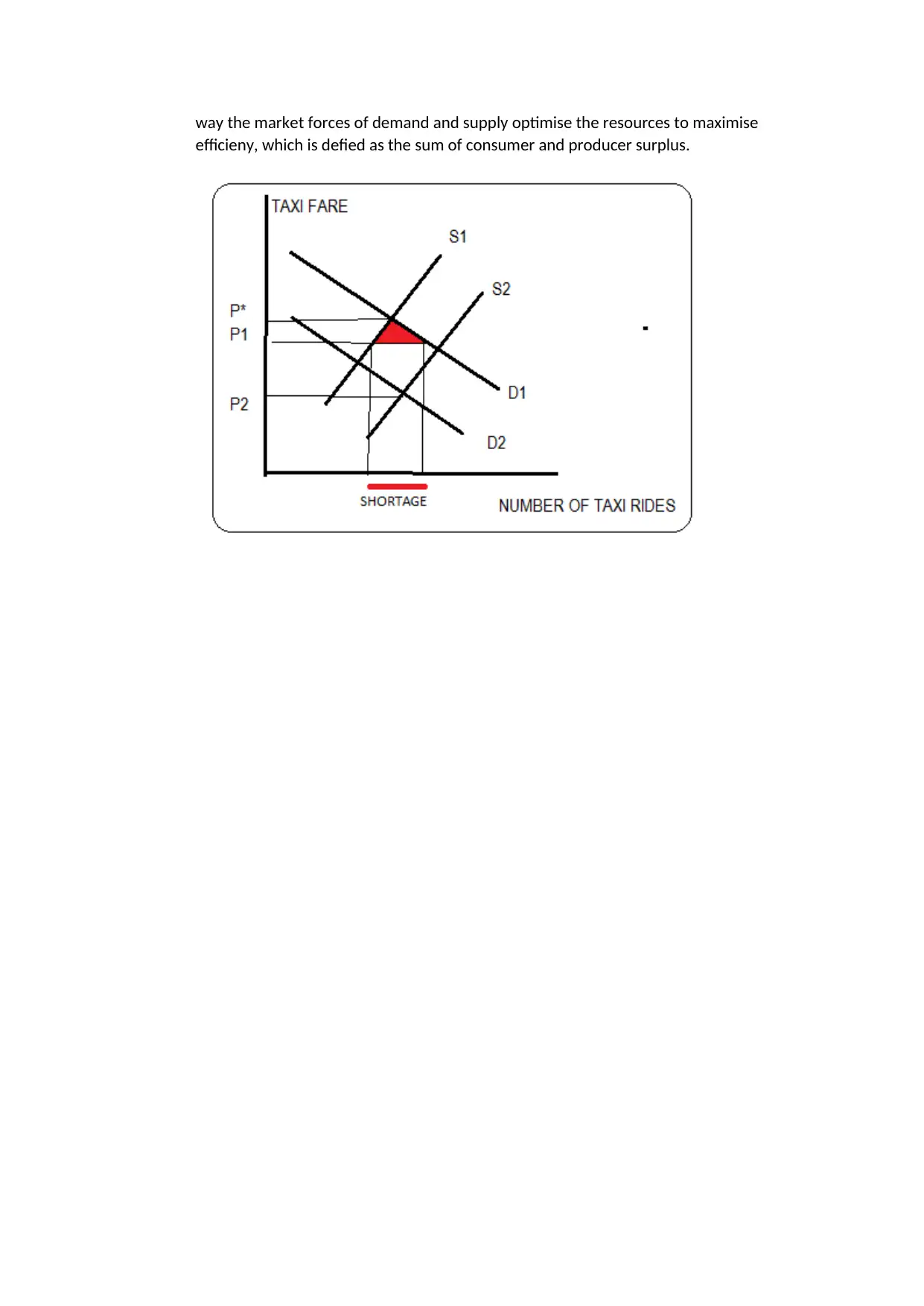
way the market forces of demand and supply optimise the resources to maximise
efficieny, which is defied as the sum of consumer and producer surplus.
efficieny, which is defied as the sum of consumer and producer surplus.
Paraphrase This Document
Need a fresh take? Get an instant paraphrase of this document with our AI Paraphraser
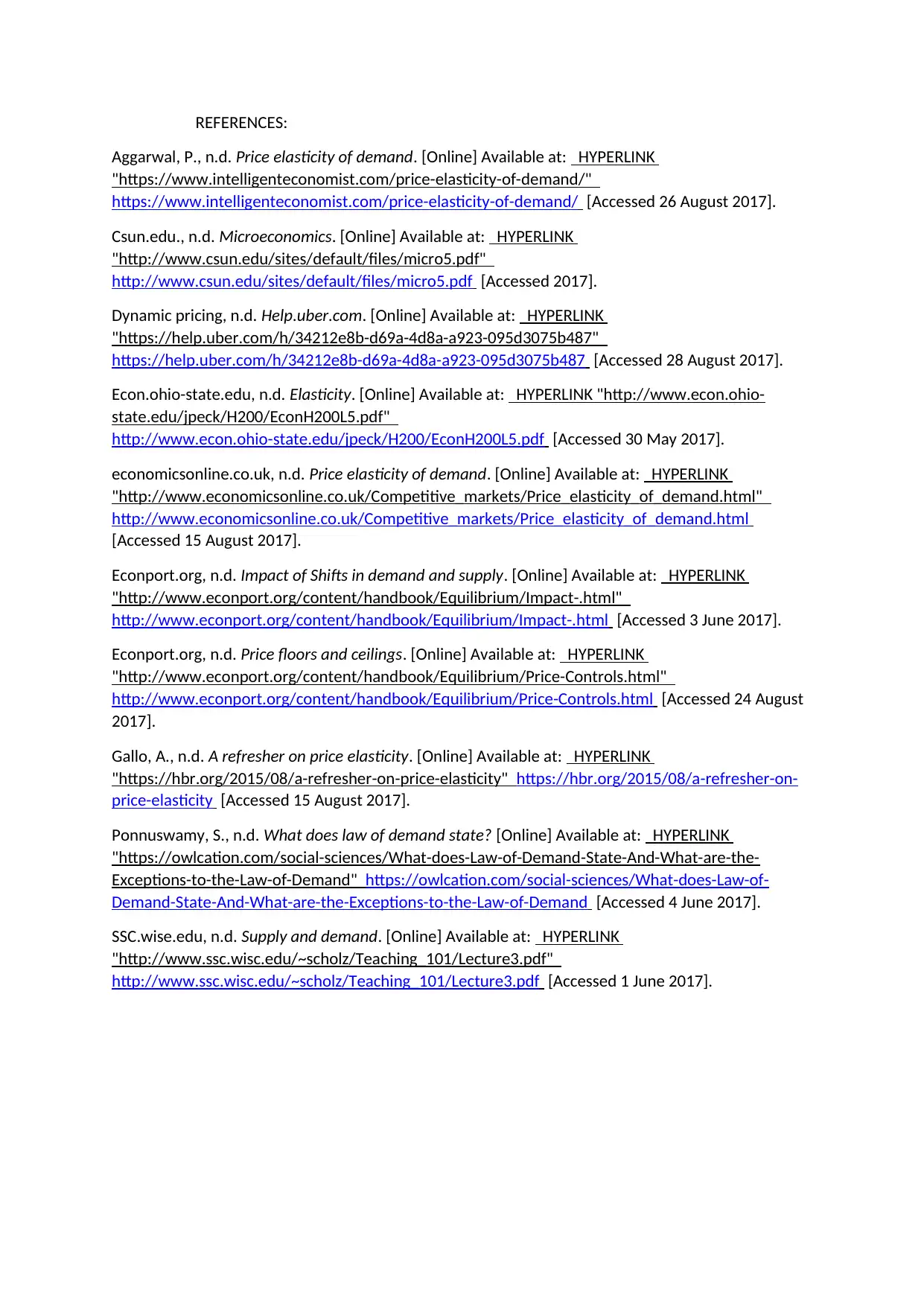
REFERENCES:
Aggarwal, P., n.d. Price elasticity of demand. [Online] Available at: HYPERLINK
"https://www.intelligenteconomist.com/price-elasticity-of-demand/"
https://www.intelligenteconomist.com/price-elasticity-of-demand/ [Accessed 26 August 2017].
Csun.edu., n.d. Microeconomics. [Online] Available at: HYPERLINK
"http://www.csun.edu/sites/default/files/micro5.pdf"
http://www.csun.edu/sites/default/files/micro5.pdf [Accessed 2017].
Dynamic pricing, n.d. Help.uber.com. [Online] Available at: HYPERLINK
"https://help.uber.com/h/34212e8b-d69a-4d8a-a923-095d3075b487"
https://help.uber.com/h/34212e8b-d69a-4d8a-a923-095d3075b487 [Accessed 28 August 2017].
Econ.ohio-state.edu, n.d. Elasticity. [Online] Available at: HYPERLINK "http://www.econ.ohio-
state.edu/jpeck/H200/EconH200L5.pdf"
http://www.econ.ohio-state.edu/jpeck/H200/EconH200L5.pdf [Accessed 30 May 2017].
economicsonline.co.uk, n.d. Price elasticity of demand. [Online] Available at: HYPERLINK
"http://www.economicsonline.co.uk/Competitive_markets/Price_elasticity_of_demand.html"
http://www.economicsonline.co.uk/Competitive_markets/Price_elasticity_of_demand.html
[Accessed 15 August 2017].
Econport.org, n.d. Impact of Shifts in demand and supply. [Online] Available at: HYPERLINK
"http://www.econport.org/content/handbook/Equilibrium/Impact-.html"
http://www.econport.org/content/handbook/Equilibrium/Impact-.html [Accessed 3 June 2017].
Econport.org, n.d. Price floors and ceilings. [Online] Available at: HYPERLINK
"http://www.econport.org/content/handbook/Equilibrium/Price-Controls.html"
http://www.econport.org/content/handbook/Equilibrium/Price-Controls.html [Accessed 24 August
2017].
Gallo, A., n.d. A refresher on price elasticity. [Online] Available at: HYPERLINK
"https://hbr.org/2015/08/a-refresher-on-price-elasticity" https://hbr.org/2015/08/a-refresher-on-
price-elasticity [Accessed 15 August 2017].
Ponnuswamy, S., n.d. What does law of demand state? [Online] Available at: HYPERLINK
"https://owlcation.com/social-sciences/What-does-Law-of-Demand-State-And-What-are-the-
Exceptions-to-the-Law-of-Demand" https://owlcation.com/social-sciences/What-does-Law-of-
Demand-State-And-What-are-the-Exceptions-to-the-Law-of-Demand [Accessed 4 June 2017].
SSC.wise.edu, n.d. Supply and demand. [Online] Available at: HYPERLINK
"http://www.ssc.wisc.edu/~scholz/Teaching_101/Lecture3.pdf"
http://www.ssc.wisc.edu/~scholz/Teaching_101/Lecture3.pdf [Accessed 1 June 2017].
Aggarwal, P., n.d. Price elasticity of demand. [Online] Available at: HYPERLINK
"https://www.intelligenteconomist.com/price-elasticity-of-demand/"
https://www.intelligenteconomist.com/price-elasticity-of-demand/ [Accessed 26 August 2017].
Csun.edu., n.d. Microeconomics. [Online] Available at: HYPERLINK
"http://www.csun.edu/sites/default/files/micro5.pdf"
http://www.csun.edu/sites/default/files/micro5.pdf [Accessed 2017].
Dynamic pricing, n.d. Help.uber.com. [Online] Available at: HYPERLINK
"https://help.uber.com/h/34212e8b-d69a-4d8a-a923-095d3075b487"
https://help.uber.com/h/34212e8b-d69a-4d8a-a923-095d3075b487 [Accessed 28 August 2017].
Econ.ohio-state.edu, n.d. Elasticity. [Online] Available at: HYPERLINK "http://www.econ.ohio-
state.edu/jpeck/H200/EconH200L5.pdf"
http://www.econ.ohio-state.edu/jpeck/H200/EconH200L5.pdf [Accessed 30 May 2017].
economicsonline.co.uk, n.d. Price elasticity of demand. [Online] Available at: HYPERLINK
"http://www.economicsonline.co.uk/Competitive_markets/Price_elasticity_of_demand.html"
http://www.economicsonline.co.uk/Competitive_markets/Price_elasticity_of_demand.html
[Accessed 15 August 2017].
Econport.org, n.d. Impact of Shifts in demand and supply. [Online] Available at: HYPERLINK
"http://www.econport.org/content/handbook/Equilibrium/Impact-.html"
http://www.econport.org/content/handbook/Equilibrium/Impact-.html [Accessed 3 June 2017].
Econport.org, n.d. Price floors and ceilings. [Online] Available at: HYPERLINK
"http://www.econport.org/content/handbook/Equilibrium/Price-Controls.html"
http://www.econport.org/content/handbook/Equilibrium/Price-Controls.html [Accessed 24 August
2017].
Gallo, A., n.d. A refresher on price elasticity. [Online] Available at: HYPERLINK
"https://hbr.org/2015/08/a-refresher-on-price-elasticity" https://hbr.org/2015/08/a-refresher-on-
price-elasticity [Accessed 15 August 2017].
Ponnuswamy, S., n.d. What does law of demand state? [Online] Available at: HYPERLINK
"https://owlcation.com/social-sciences/What-does-Law-of-Demand-State-And-What-are-the-
Exceptions-to-the-Law-of-Demand" https://owlcation.com/social-sciences/What-does-Law-of-
Demand-State-And-What-are-the-Exceptions-to-the-Law-of-Demand [Accessed 4 June 2017].
SSC.wise.edu, n.d. Supply and demand. [Online] Available at: HYPERLINK
"http://www.ssc.wisc.edu/~scholz/Teaching_101/Lecture3.pdf"
http://www.ssc.wisc.edu/~scholz/Teaching_101/Lecture3.pdf [Accessed 1 June 2017].
1 out of 5
Related Documents
Your All-in-One AI-Powered Toolkit for Academic Success.
+13062052269
info@desklib.com
Available 24*7 on WhatsApp / Email
![[object Object]](/_next/static/media/star-bottom.7253800d.svg)
Unlock your academic potential
Copyright © 2020–2025 A2Z Services. All Rights Reserved. Developed and managed by ZUCOL.





